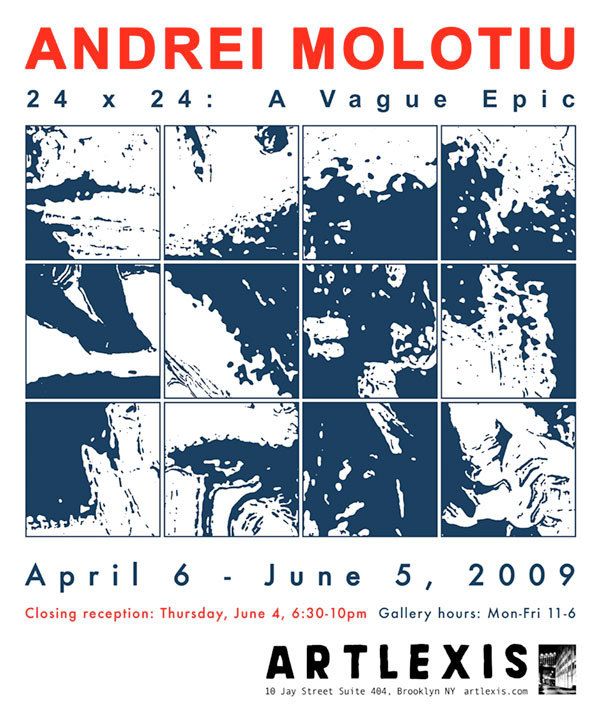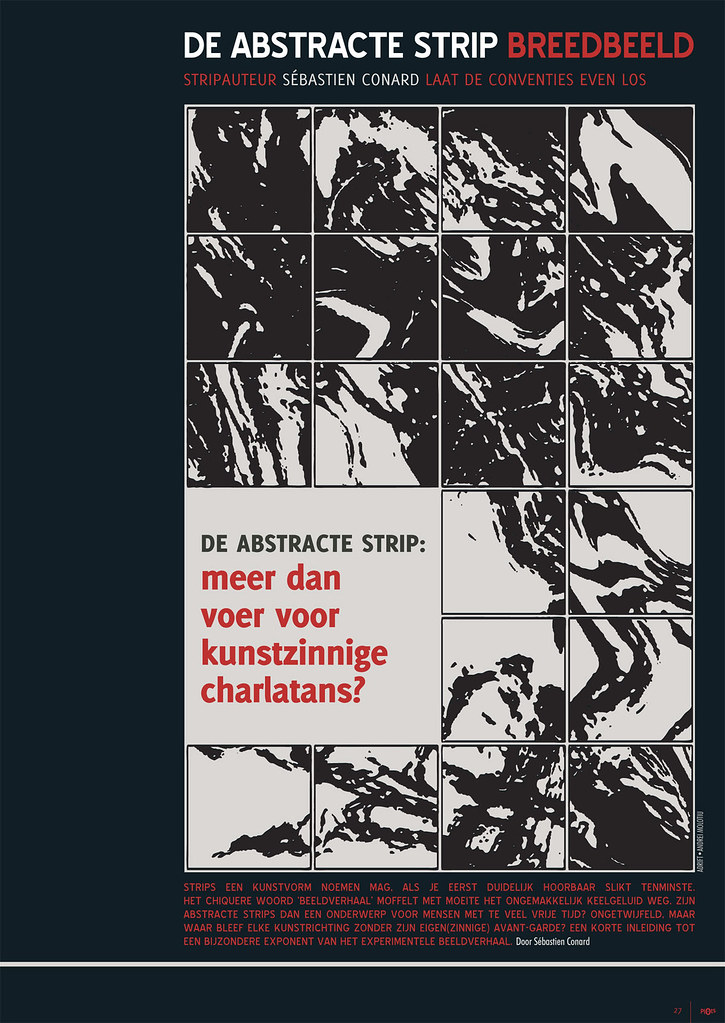
I just got the proof for the invite, which you see here.
More info later.

Strips, allegedly still an art but if a loud, public mud. The fancier word story moffelt trouble with the uncomfortable throat sound way. Abstract strips than a topic for people with too much time? No doubt, but where was any art direction without its own (sensible) avant-garde? Consider this special exponents of the experimental story and dare you to this brief introduction to the STRIP ABSTRACT.
By Sebastien Conard
As the film is a form of popular entertainment as a child none of press rolls and newsprint, long remained a comic strip for the under inartistic people, morons, children and the illiterate. The wrikt is however independent of this image and after the revolution of the 60s there is a mature story. In the mature work after May'68 (the "graphic novel" included) is however what substance until the French 'nouvelle vague' from early 90s the new medium inblaast. On the menu are somewhat less weightiness and a no-nonsense approach to both young and old. Rising star was' L'Association, including David B., Blain, Blutch, Sfar and Lewis Trondheim ubiquitous. An introduction to abstract visual can without embarrassment 'to this centipede begin. The man has for years had an eye for everything in the strip of grass moving and ventured to many. Moreover, he was a central figure of the 'oubapo (ouvroir the bande dessinée potentielle) as the experimental counterpart of the' oulipo (ouvroir the littérature potentielle): all kinds of creative Spielerei based on shape restrictions.
Bleu (Trondheim)
In 2003, Trondheim steal a small blue booklet: 'Bleu'. This apparent sequence from one another takeover, repellent and split income amoebas applies now as a classic in the genre of abstract strip. The genre is so far distant origin in a funny eenpaginagag Maurice Rosy in stripblad Spirou and some psychedelic SF (s) breaks master Giraud / Moebius in the magazine Chaos (1989).
El Lissitzky
On bulledair.com is itself refers to "About 2 squares, a 12-piece set of compositions constructivist El Lissitzky (1922). How could it otherwise than in the Russian avant-garde start? After 'Bleu' to Trondheim in 2006 "La nouvelle Pornographie from, another abstract, formal sex game that he, as it were from inside the female body looks.
La Nouvelle Pornographie (Trondheim)
Again pretty funny but not particularly exciting. Moreover, the abstract to the extent that it is minimalist and only read a certain code is required to fully understood. Something similar applies for TNT and America 'by Jochen Gerner (2002) and "Poor Indian' Tom Lambeens (2008). The first is an exercise which Gerner oubapo the pages of Hergé's Tintin and America 'fully dyed black but there uitspaarde text on the modern, violent society of the USA. The original color planes he saved only icons that relate to the already saved words. In Lambeens’ In Lambeens' Poor Indian 'can enjoy the repetitive sequences and the detailed layout uitgedokterde the full reading required here cracking a code.
Ibn al Rabin
But let us back in time: early 2000 Trondheim contributes to the visual escapades of Ibn al Rabin and konsoorten. With 'L'Association gradually depopulated by the lokroep of commercial publishers, profiles the Swiss' Atrabile' as a fresher and younger group. Since the thirteenth number (2003) of their stripblad 'Bile Noire' maintains strip minimalist Ibn al Rabin a chapter abstract strip. In addition to Trondheim and Ibn al Rabin car Frederik Peeters, Guy Delisle, Andreas Health and others at the genre. Yet they all continue to fluctuate around the same idea and they merely abstract figuration. That they are not so far from the surreal strips Silvestre, Olivier Marboeuf and others in the publishing arty Frémok. In both cases you get strips of geometric figures fulfill the role of characters and dialogue with each other (with or without text). Moreover, beyond the image of a rare follow-up series animation stills (snapshots).
Andrei Molotiu
Jessie Bi, Stéphane Girod and Mark Staff Brandl make everything work crazier but it is truly fascinating with Andrei Molotiu, an American who for some exercise on blotcomics.blogspot.com. His abstraction beyond the grid of boxes, because usually is a comic page Molotiu is an abstract composition. Similarly, the strips of Bruno Schaub (Brusche) on bdabstraite.canalblog.com. You get the story right? Then maybe you get expert 'le Carré de fait du ski Malevich, how over a white page displays ... You do not have to strip so as Malevich original.
Greg Shaw-Veuve Poignet
All these examples are rare abstraction of sequentialiteit itself. In other words, they have replaced the familiar figures within the frameworks more geometric shapes but hardly play with the actual sequence of multiple image frames on a page. See also the beautiful 'Popeye and Olive "by Richard McGuire (Cornelius, 2001): a minimalist pop art treatment of the silhouettes of the classic American comic strip couple. But again limits the abstraction to figuration. Where do we or those extracted sequentialiteit? Greg Shaw was one passage in there and let Atrabile 'Walk pictorial' (2005) after. This change gepixeleerde planes of color and in their mutual relations, while the layout of the framework evolves. (Who incidentally means of pixels must agree to practice the abstract machine strip of Health: www.darksite.ch/kundig/abstrait/automatique.php ) The Brussels'5 e Couch 'brought Greg Shaw than Veuve Poignet (2006) from another step further. It reduces the interaction between text and the sequence of images to a minimum abstract. By reading the rows color boxes to connect to a text legend, he plays with the basic codes of the story. Indeed, a series of images will only significant due to the accompanying text and vice versa. That this book an ode to masturbation and is thematically close to 'La nouvelle Pornographie' is doing some suspicion that one of Greg Shaw Trond Heim many passers-double is. (See also the online mysteries around the blogs and Frantico Jerry Tongdeum).
In addition to these formal abstractions, the visual experiments at the level of text and narrative. Even with figurative and very classic, realistic forms a strip in abstract texts and story structure. Trondheim supplied with a Menu on in that direction. 'Moins d'un quart the second pour vivre (1990) was a oubapo exercise of the first hour on the same sort of images in each sequence and to provide appropriate text. Yet the real perfect example of abstract narrative 'The Cage' (1975) by Martin Vaughn-James: a succession of perfectly readable snapshots off brokkelde and shiver ran interiors, subtitled by an independent text only atmosphere in relation to the images. The story is entirely abstract, emotional and character-based but carved in shape realistic still lifes. Here are the authors of Fremok report worthy. In their article stie kereteken strips often we find a preference for the abstract language of colors and textures back. However, the images are usually figurative and already read. The texts and storylines, however poetic, indirect or even hermetically. Today, the experimental Matière publishing the work of Yuichi Yokoyama, who with only slightly abstract images very abstract stories offers.
Yuichi Yokoyama
In 'Travaux publics' (2004),' Combat '(2004) and "Voyage" (2005) provides futuristic Yokoyama pressing and public works, conflicts and travel. The images are clear (a workman is a workman, a spaceship a spaceship, etc.) but the story leads nowhere or in other words abstract. His strips are also full of Japanese onomatopeeën, dynamic movement lines and detail shots, so he creates a timeless image of an out of modernity.
The term abstract swallowed all the same difficulties as the situations in which it is applied. Often seems an excuse for artistic charlatans and other Kramers of hot air. Because air or at least a little lightness, there is the question. Ibn al Rabin: 'C’est un truc amusant sur lequel on peut faire plein d’essais et qui en plus permet de s’offrir une contenance en cocktail en balançant des explications bourrées de mots plus grands que soi'(Bile Noire, Atrabile, 2006) that the general public it is sometimes difficult, especially when it comes to comics as a popular child is, is probably the lack of tangibility. Because if the abstraction is to extract the visible reality, the concrete and tangible, as there is still about?
I like experimental strips. But this is something I am too far. Sometimes in a cold I think such things in my handkerchief, after the blow of my nose. No thanks, I'm for this kind experimlenten apparently not yet ready.
Then, best Gay, I urge you strongly to be creative to deal with your handkerchiefs. Not washing please!









copyright Andrei Molotiu 2005-2013
